PONTIAC PONTIAC 1996 Owners Manual
Manufacturer: PONTIAC, Model Year: 1996, Model line: PONTIAC, Model: PONTIAC PONTIAC 1996Pages: 370, PDF Size: 17.69 MB
Page 201 of 370

/r\, CAUTION:
A vehicle can fall from a car carrier if it isn’t
adequately secured. This can cause
a collision,
serio’us personal injury and vehicle damage. The
vehicle should be tightly secured with chains or
steel cables before it
is trapported.
Don’t
use substitutes (ropes, leather straps,
canvas webbing, etc.)
that can be cut by sharp
edges underneath the towed vehicle. Always use
T-hooks inserted in the T-hook slots. Never use
J-hooks. They will damage drivetrain and
suspension components.
~~
When your vehicle is being towed, have the ignition
turned
to the OFF position. The steering wheel should
be clamped in a straight-ahead position, with a
clamping device designed
for towing service. Do not
use the vehicle’s steering column lock for ths The
transaxle should be
in NEUTRAL (N) and the
parking brake released.
Don’t have your vehicle towed on the drive wheels,
unless you must. If the vehicle must be towed on the
drive wheels, be
sure to follow the speed and distance
restrictions later in this section or
your transaxle will be
damaged.
If these limitations must be exceeded, then the
drive wheels have to be supported on a dolly.
ProCarManuals.com
Page 202 of 370
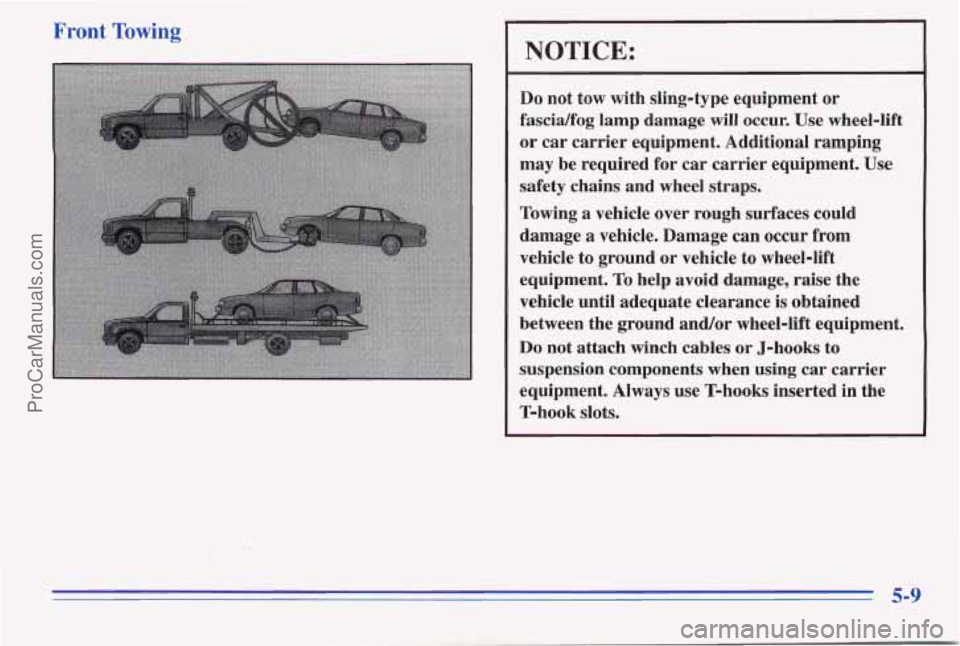
Front Towing
NOTICE:
Do not tow with sling-type equipment or
fascidfog lamp damage
will occur. Use wheel-lift
or car carrier equipment. Additional ramping
may be required for car carrier equipment.
Use
safety chains and wheel straps.
Towing a vehicle over rough surfaces could
damage
a vehicle. Damage can occur from
vehicle to ground or vehicle to wheel-lift
equipment.
To help avoid damage, raise the
vehicle until adequate clearance
is obtained
between the ground and/or wheel-lift equipment.
Do not attach winch cables or J-hooks to
suspension components when using car carrier
equipment. Always use
T-hooks inserted in the
T-hook slots.
5-9
ProCarManuals.com
Page 203 of 370
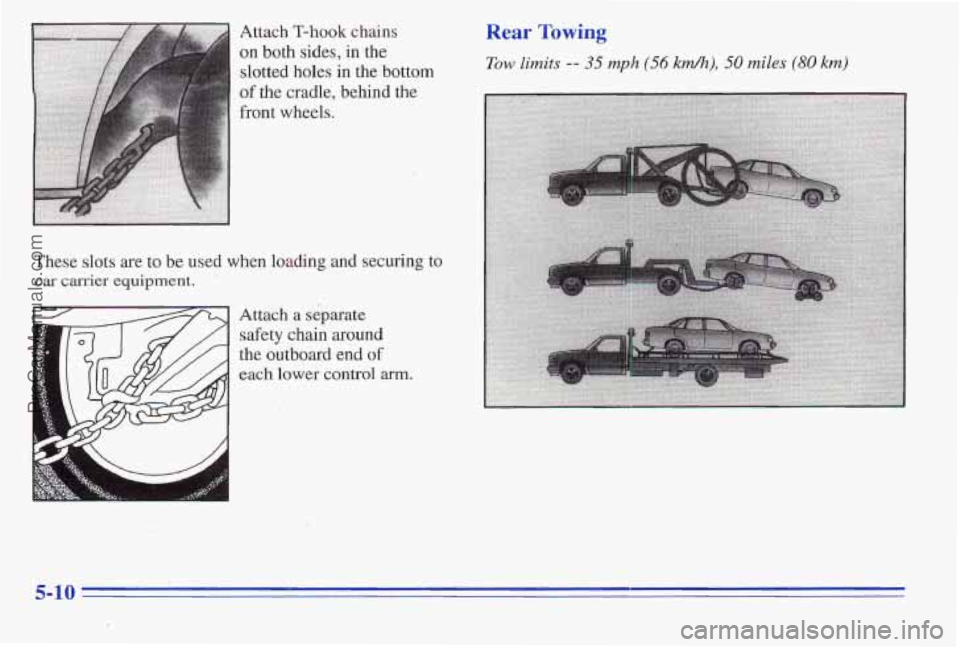
Attach T-hook chains
on both sides, in the
slotted holes in the bottom
of
the cradle, behind the
front wheels.
These slots are to be used when loading and securing to
car carrier equipment. '
'1
Attach a s&pamte
safety chain around
the outboard end of
each lower control arm.
5-10
ProCarManuals.com
Page 204 of 370
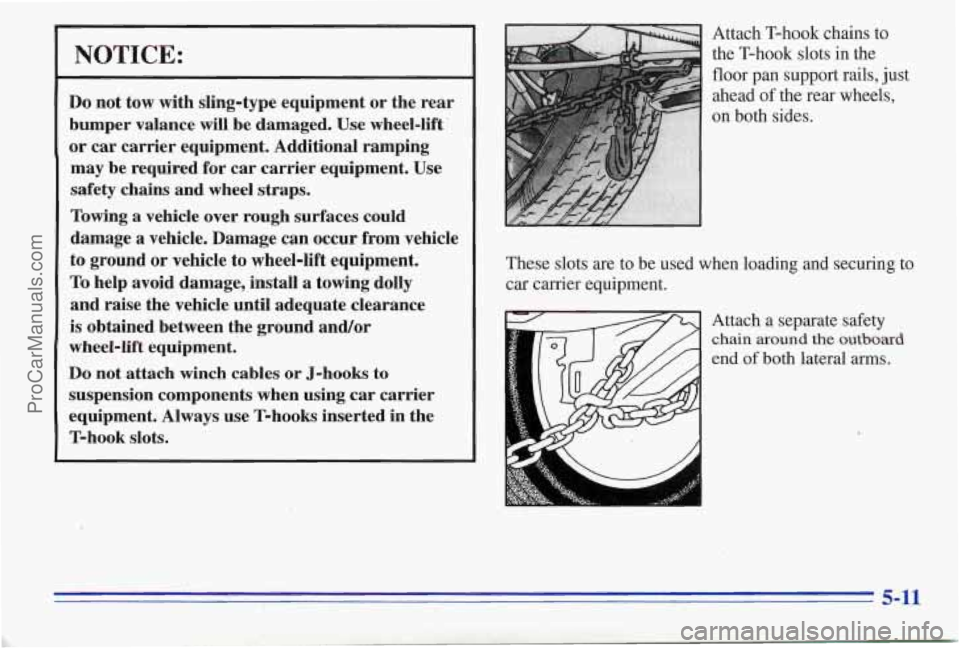
NOTICE:
Do not tow with sling-type equipment or the rear
bumper valance
will be damaged. Use wheel-lift '
or car carrier equipment. Additional ramping
may be required for car carrier equipment. Use
safety chains and wheel straps.
Towing a vehicle over rough surfaces could
damage a vehicle. Damage can occur from vehicle
to ground or vehicle to wheel-lift equipment.
To help avoid damage, install a towing dolly
and raise the vehicle until adequate clearance
is obtained between the ground and/or
wheel-lift equipment.
Do not attach winch cables or J-hooks to
suspension components when using car carrier
equipment. Always use T-hooks inserted in the
T-hook slots.
Attach T-hook chains to
the T-hook slots
in the
floor pan support rails, just
ahead of the rear wheels,
on both sides.
These slots are to be used when loading and securing to
car carrier equipment.
Attach a separate safety
chain around the outboard
end of both lateral arms.
5-11
ProCarManuals.com
Page 205 of 370
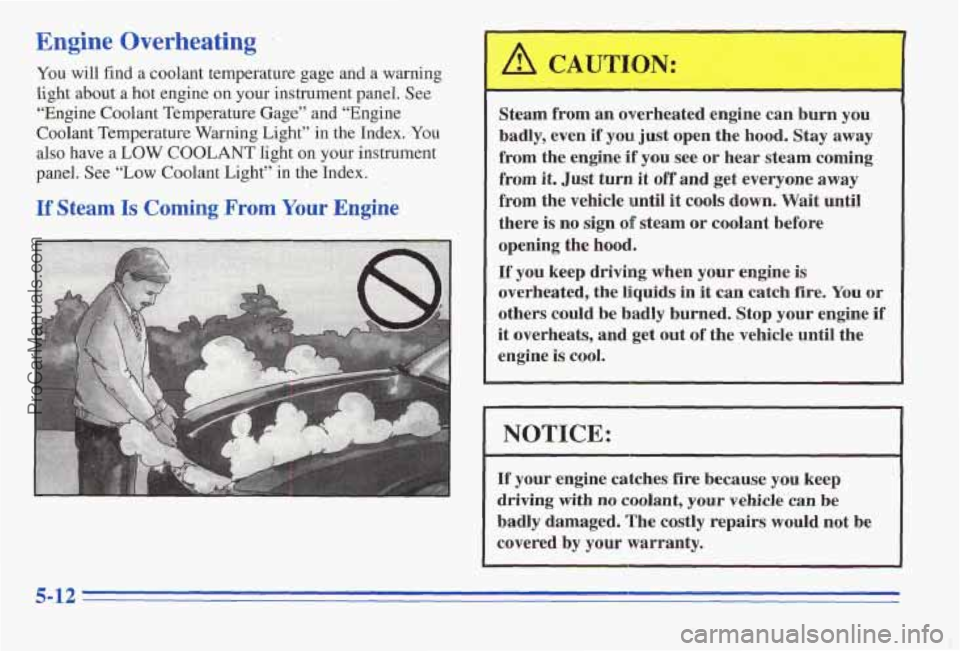
Engine Overheating
You will find a coolant temperature gage and a warning
light about a hot engine on your instrument panel. See
“Engine Coolant Temperature Gage” and “Engine
Coolant Temperature Warning Light” in the Index. You
also have
a LOW COOLANT light on your instrument
panel. See
“Low Coolant Light” in the Index.
If Steam Is Coming From Your Engine
Steam from an overheated engine can burn you
badly, even if you just open the hood. Stay away
from the engine
if you see or hear steam coming
from it. Just turn it off and get everyone away
from the vehicle until
it cools clown. Wait until
there
is no sign of steam or coolant before
opening the
hood.
If you keep driving when your engine is
overheated, the liquids in it can catch fire, You or
others could be badly burned. Stop your engine if
it overheats, and get out of the vehicle until the
engine
is cool.
I I
NOTICE:
If your engine catches fire because you keep
driving with no coolant, your vehicle can be
badly damaged. The costly repairs would not be
covered by
your warranty.
5-12
ProCarManuals.com
Page 206 of 370
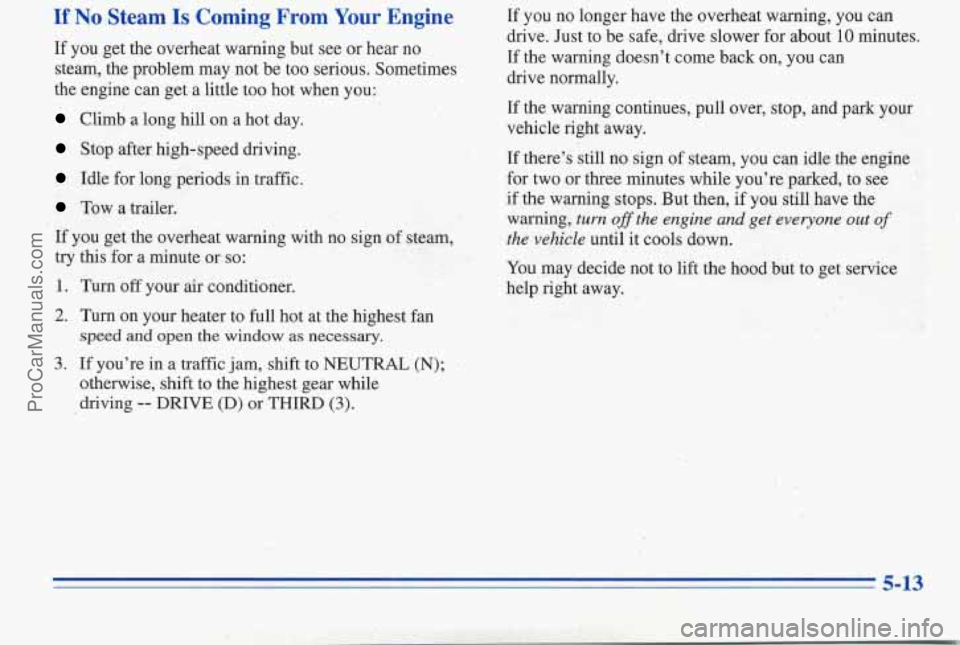
If No Steam Is Coming From Your Engine
If you get the overheat warning but see or hear no
steam, the problem may not be too serious. Sometimes
the engine can get a little too hot when you:
Climb a long hill on a hot day.
Stop after high-speed driving.
Idle for long periods in traffic.
Tow a trailer.
If you get the overheat warning with no sign of steam,
try this for a minute or
so:
1. Turn off your air conditioner.
2. Turn on your heater to full hot at the highest fan
3. If you’re in a traffic jam, shift to NEUTRAL (N);
speed and open the window as necessary.
otherwise, shift to the highest gear while
driving
-- DRIVE (D) or THIRD (3).
If you no longer have the overheat warning, you can
drive. Just to be safe, drive slower for about
10 minutes.
If the warning doesn’t come back on, you can
drive normally.
If the warning continues, pull over, stop, and park your
vehicle right away.
If there’s still no sign of stem, you can idle the engine
for two or three minutes while you’re parked, to see
if
the warning stops. But then, if you still have the
warning, turn oJffthe engine
and get everyone out of
the vehicle until it cools down.
You may decide not to lift
the hood but to get service
help right away.
5-13
ProCarManuals.com
Page 207 of 370
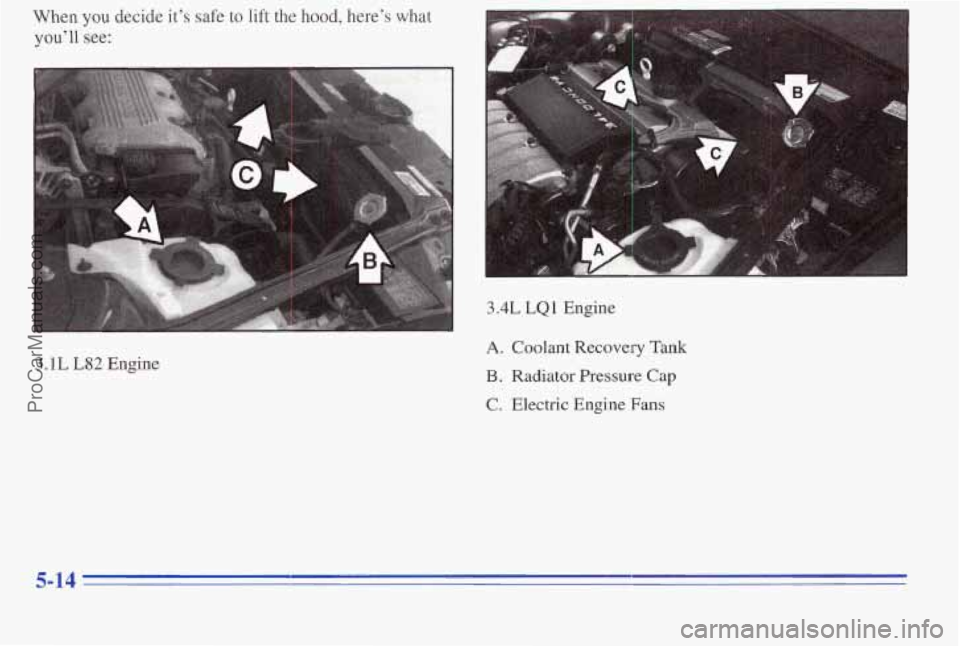
When you decide it’s safe to lift the hood, here’s what
you’ll see:
3.4L LQ1 Engine
3.1L L82 Engine
A. Coolant Recovery Tank
B. Radiator Pressure Cap
C. Electric Engine Fans
ProCarManuals.com
Page 208 of 370
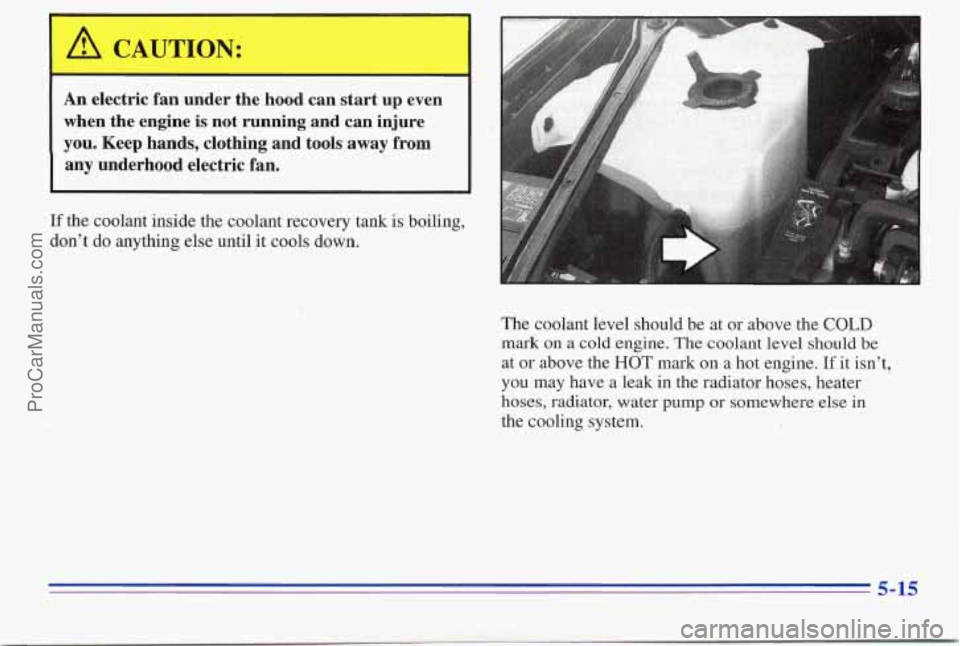
An electric fan under the hood can start up even
when
the engine is not running and can injure
you. Keep hands, clothing and tools away from
any underhood electric fan.
If the coolant inside the coolant recovery tank is boiling,
don’t do anything else until
it cools down.
The coolant level should be
at or above the COLD
mark on a cold engine. The coolant level should be
at or above the HOT mark on a hot engine. If it isn’t,
you may have a leak
in the radiator hoses, heater
hoses, radiator, water pump or somewhere else in
the cooling system.
5-15
ProCarManuals.com
Page 209 of 370
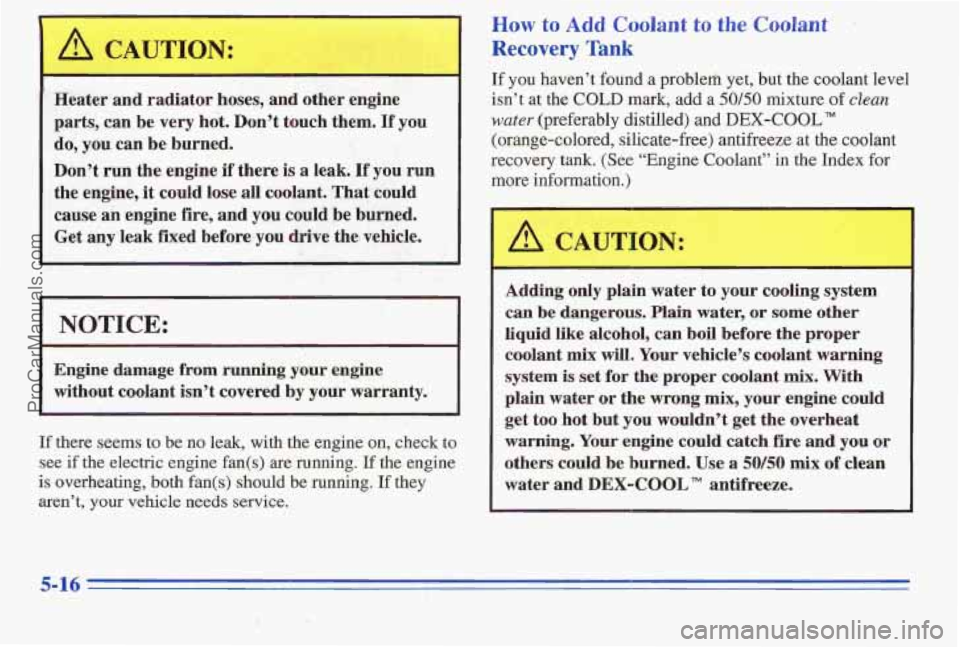
A CAUTION:
I
Heater and radiator hoses, and other engine
parts,
can be very hot. Don’t touch them. If you
do, you can
be burned.
Don’t run the engine
if there is a leak. If you run
the engine,
it could lose all coolant. That could
cause
an engine fie, and you could be burned.
Get
any ‘leak fixed before you drive the, vehicle.
I NOTICE:
I
Engine damage from running your engine
without coolant isn’t covered by your warranty.
I
If there seems to be no leak, with the engine on, check to
see if the electric engine fan@) are running. If the engine
is overheating, both fan(s) should be running. If they
aren’t, your vehicle needs service.
How to Add Coolant to the Coolant
Recovery Tank
If you haven’t found a problem yet, but the coolant level
isn’t at the COLD mark, add a 50/50 mixture of ckm
water (preferably distilled) and DEX-COOL”
(orange-colored, silicate-free) antifreeze at the coolant
recovery
tank. (See “Engine Coolant” in the Index for
more information.)
Adding only plain water to your cooling system
can be
dangerous. Plain water, or some other
liquid Eke alcohol, can boil before the proper
coolant
mix will. Your vehicle’s coolant warning
system
is set for the proper coolant mix. With
plain water or the wrong mix, your engine could
get too hot but you wouldn’t get the overheat
warning.
Your engine ‘could catch fire and you or
others could be burned. Use a
50/50 mix Q€ clean
water and
DEX-COOL antifreeze.
5-16
,LC !
ProCarManuals.com
Page 210 of 370
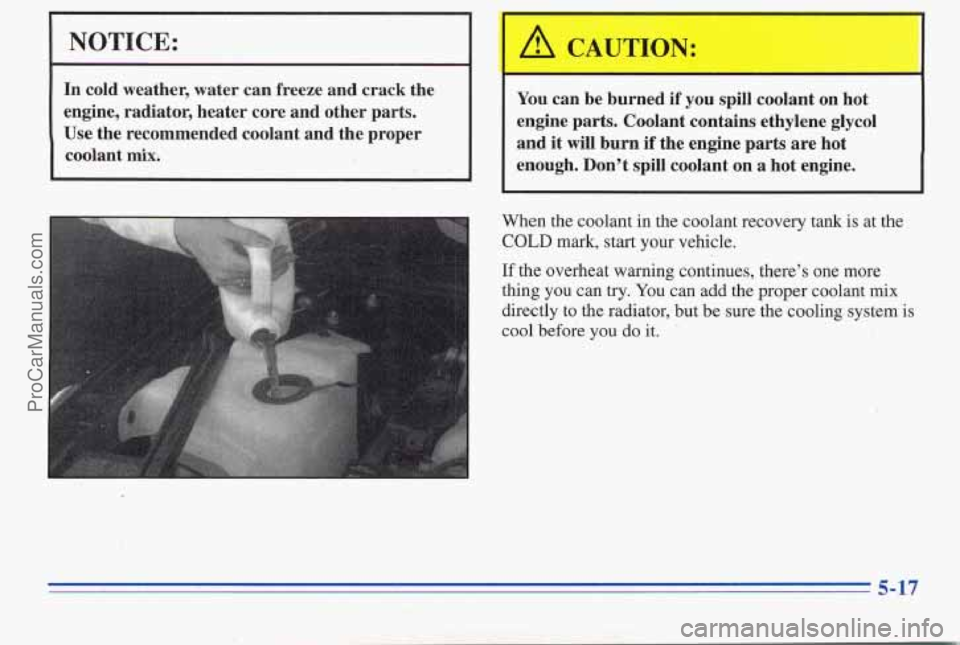
NOTICE:
In cold weather, water can freeze and crack the
engine, radiator, heater core and other parts.
Use the recommended coolant and the proper
coolant
mix.
You can be burned if you spill coolant on hot
engine parts. Coolant contains ethylene glycol
and
it will burn if the engine parts are hot
enough. Don't spill coolant on a hot engine.
When the coolant in the coolant recovery tank is at the
COLD mark, start your vehicle.
If the overheat warning continues, there's one more
thing you can
try. You can add the proper coolant mix
directly to the radiator,. but be sure the cooling system is
cool before
you do it.
5-17
ProCarManuals.com